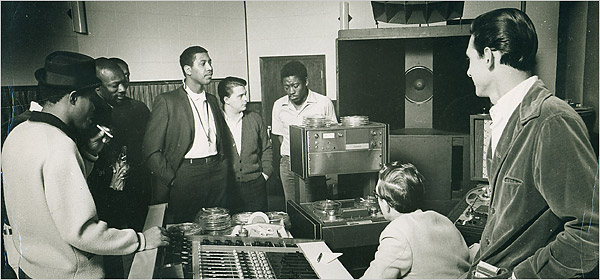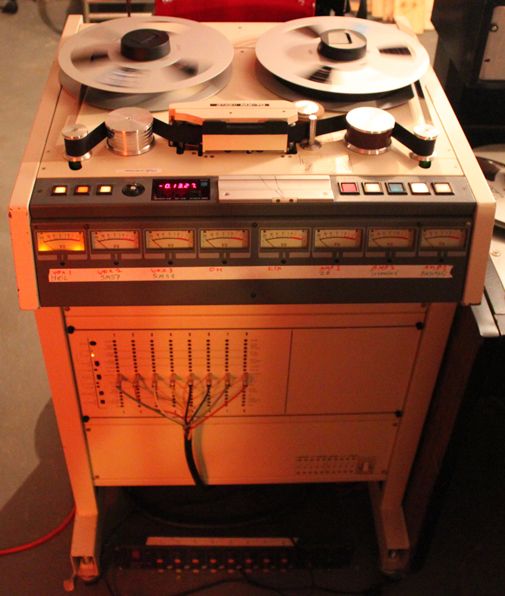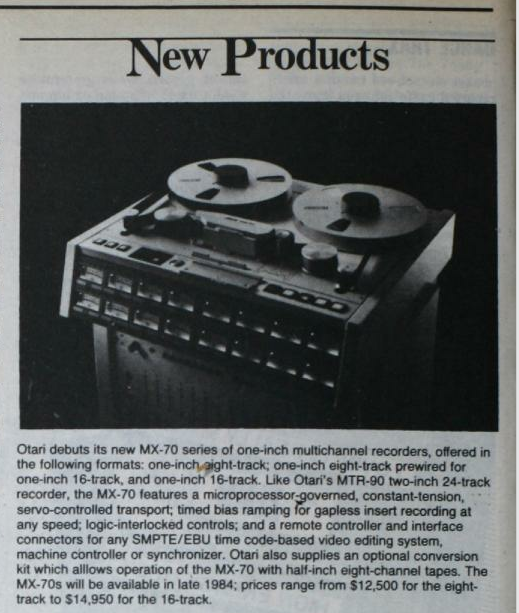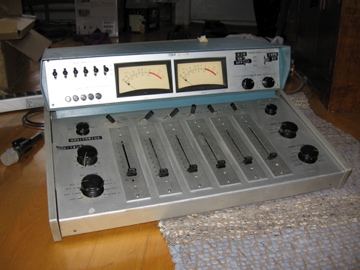This is our main mixdown deck. For the first two years we owned this machine, it had an annoying habit of falling out of record mode. Because of this, we relegated it to tape echo, rewinding and other secondary duties. We replaced every single electrolytic capacitor in the machine chasing down the prob, but it ended up being just a little jumper that wasn’t pushed in properly. Boy, do we ever feel stupid.
Now it’s just a sweet sounding late-70s Swiss mastering deck that gives us no sass and just happens to match our console.


Posted in Tape Machines | No Comments »
Tho it only records one track, it’s the best sounding tape machine we have. This mechanical marvel was built circa 1965, and after replacing the electrolytic capacitors, it performs up to the specs in the manual. Compared to our other machines, the fast winding torque is truly terrifying.


A certain AL JACKSON JR leaning against an AG-350

Posted in Tape Machines | No Comments »
This is our favourite multi-track machine. It looks like 80s hospital equipment.
Interesting features:
- Lets you store two bias settings per speed.
- Switchable speed pairs (7.5/15ips or 15/30ips)
- ‘Global input’ for all 8 channels for quick and easy alignments
- Very nice sound


Posted in Tape Machines | 4 Comments »
EDIT: We have since replaced this console with a linked pair of Studer 169s
We use the Tascam M-520 here, and we like it quite a lot. It’s very intelligently laid-out and it has great routing options. And the build quality is superb. Our only quibbles with this desk are the design of its channel mutes (they’re prone to getting noisy) and its somewhat limited EQ (I’m cool with the fixed bandwidth, but I wish the Q was broader).
Here the brochure for this mixer and its little brother (the 12 channel M-512):
M-500 series brochure
And here’s the manual (minus the schematics):
M-520 manual
Tip: The manual has a great section on the fundamentals of sound engineering that’s really useful for any novice or intermediate analogue recordist.
And finally here’s some weird, elaborate, interactive flash model of the mixer:
Interactive M-520
We recently gave our M-520 a bit of a cleaning. So if you have this mixer, or are thinking of acquiring one, here’s what the channel strips look like when disassembled:

Tascam M-520: the knobs from a one ‘bucket’ of four channels

These pin-and-header connectors are a bit fragile; the pots are all bolted to the metal–which is great for durability, but a major pain-in-the-ass to disassemble for cleaning

It’s not a bad idea to label those headers

Yep, that’s a lot of annoying ITT Schadow switches to clean…

Another view of the channel buckets disassembled.
Posted in Consoles | 8 Comments »

This small mixer from the late-1960s is one of our favourite pieces of equipment. The workmanship and wiring is impeccable; the circuitry is simple; and the components are top notch. We’re particularly enamored with the sound of the PE2600’s preamps (we suspect the custom MRI–McCurdy Radio Industries–transformers contribute to the sonic heft) and its use of virtually indestructible (and noiseless) stepped attenuators.

McCurdy preamp card; we’ve since replaced the electrolytic capacitors
The late Howard M. Tremaine, a titan of professional audio equipment design and the author of the venerable Audio Cyclopedia, worked for McCurdy during the 1960s, but we’re not sure if he contributed to the design of this mixer.
We performed one small modification to this unit, removing redundant microphone inputs and replacing them with direct outputs for each channel.
Posted in Consoles | 4 Comments »















 |
|